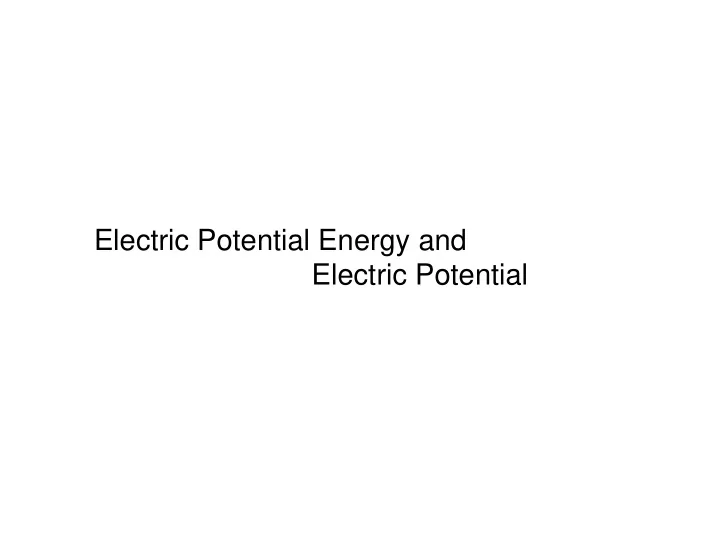

Electric Potential Energy and Electric Potential
Work x y z f f f Work done W by a force F F dx F dy F dz x y z x y z i i i x y z f f f F F dx F dy F dz x y z x y z i i i x y z f f f F dr F dr F dr x x y y z z y x y z i i i r f Work done W by a force F F d r r f F r i dr x dr r i F
Potential energy K K K Work done by electric force F f i E Work done by other forces F i Static electric is conservati ve, so we can define electric potential energy U as : E U - Work done by electric force F E E K - U Work done by other forces F E i y K U Work done by other forces F i r f F dr x dr r i F
Electric Potential Static E(r) is conservative, the potential difference V is defined as the negative work done by the force F(r) (which is path independent), divided by the charge (of the test charge). f B 1 1 U - F ( r ) d r ` ` i Pay attention to the negative sign f U V - E ( r ) d r 1 A q ` i Unit of electric potential = J/C =V
Warning In the discussion here we will assume electric (force) field is a conservative (force) field. This will not be the case if there is a changing magnetic field. We will come to this point later in the semester.
Potential Difference and Potential If we can define a point Z in space as a point with zero potential, then the potential of all other points in space is defined. Z (V=0 at this point) 1 1 ` ` Z V at point A - E ( r ) d r A If the problem involves only 1 A potential difference (e.g. ` conservation of energy), the V=? choice of this zero point is not important.
Class 13. Calculation of Electric Potential
Electric potential of a Point Charge This is important because from this we can calculate the potential of any source charge assembly. E Q V 4 r 0 Q V=0 at r=
Electric potential of a Constant Field y y=0 V - Ey - y 2 0 V=0 at the sheet of source charges (y=0)
General Observations 1. Electric field tends to point from a high potential point to a low potential point. 2. If you release a test charge particle from rest and let it go along the field line for a short time, the particle will go from a high potential point to a low potential point if it is positive in charge. In reverse, it will go from a low potential point to a high potential point if it is negative in charge.
Calculating Electric Field from Electric Potential Given an electric field, we can calculate the corresponding potential Z V at point A - E ( r ) d r A In reverse, given an electric potential, we can calculate the corresponding field: V V V ˆ ˆ ˆ E - V - i - j - k x y z
Calculate the electric potential due to the source charges Electric potential due to a point charge: 1 Q r V V(r) E 1 4 r Q 0 Electric potential due to several point charges: V 1 +V 2 +V 3 r 1 1 Q i r 3 E Q 1 r 2 4 r i 0 i Q 2 Q 3 Electric field due to continuous charge distribution: r 1 dQ dE V dV dQ 4 r 0 Note that electric potential is a scalar, it is easier to calculate than electric field (vector).
Calculate Change in Potential Energy If you move a small test charge (so small that it will not affect the charge distribution of the source) of charge q from point i to point f, the change in its potential energy is U = q (V f – V i ) and now you can use conservation of energy to solve problem: K + U = 0
Recommend
More recommend